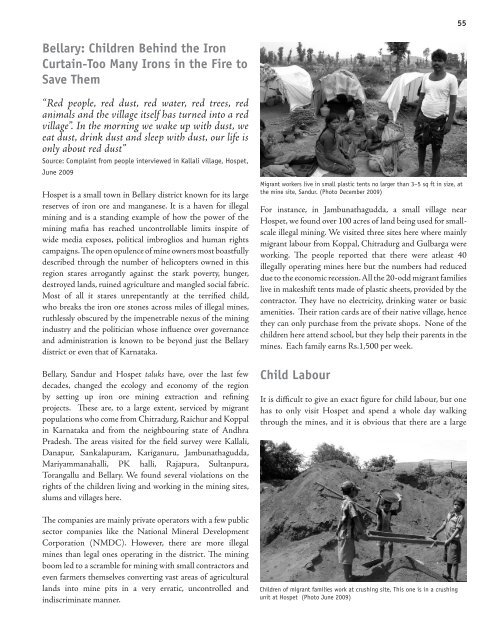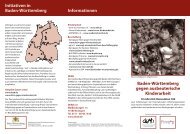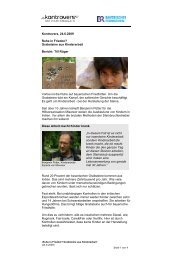54has created a peculiar aesthetics for tourism and the filmindustry, the workers and the Medical Officer interviewed,were suspicious that some of the health problems could berelated to radiation or dust pollution associated with the minetailing or the cyanide hill. While media reports in the pastindicate probable health problems, there has been no scientificstudy done to take any safety precautions or protection of theenvironment and water bodies.Access to WaterClosed BGML Hospital in Kolar township which provided free medical servicesfor workers and their famililes (Photo June 2009)requirements of the township as well as the general public ofthe taluka as it is highly understaffed. The Medical Officerreported that the workers mainly suffer from respiratoryillnesses, chronic bronchitis, asthma, tuberculosis (TB) andsilicosis although the latter is not an officially confirmeddiagnosis as most silicosis patients, to the convenience ofthe state and the industry, are diagnosed with tuberculosis.The health problems of the children, as reported by theMedical Officer relate to respiratory illnesses, skin diseases,bronchitis and malaria. The Medical Officer also stated thatthere were cases of HIV/AIDS and Sexually TransmittedDiseases (STD) but it was hard to state whether they werefrom the township or outside as the workers do not have aseparate hospital now. The workers’ families are unable tomeet the medical expenses, so some of the workers’ unions arevoluntarily helping the families in accessing medical facilities.Therefore the burden of supporting the families has fallen onthe youth again.The mine tailings or the cyanide hill as it is popularly knownis located in the center of the township. Ironically, while itWater scarcity is one of the most serious problems reportedby the people who state that while they live above gallonsof accumulated groundwater from the aquifers ruptured bythe mining activity, they do not have access to safe drinkingwater. Water shortage is felt round the year and as they haveto pay for the water supplied to them, the sanitation andhygiene of the township is of serious concern.ConclusionsKGF was a public sector mining company, yet it couldnot set any practice for a comprehensive mine closure.The government simply walked away from the problemwith justified grounds of lack of unity among the unions.Mining is a sector with high economic stakes and withthe strongest risk to democracy as decisions are madeon the basis of muscle power rather than on behalf ofthe good of the majority, whether during the course ofmining or post-mining. KGF is a standing example ofthis fix. Although there is no other community living hereother than the workers’ community, no definitive futureplan has emerged so far that the government can set as aprecedent for private companies to follow. As India rushesinto public-private partnerships and privatisation of themining sector, accountability from mining companiesduring or after a mining project, its specific impacts onchildren and youth, has little demands, expectations,regulations or monitoring that can ensure socio-economicviability post-mining.(Acknowledgements: This case study was done in partnershipwith Sakhi, Hospet, and Mr.Kumar, freelance journalist ofKolar who together organised the field visits to KGF. Wethank them for accompanying us to the KGF township andhelping with the field interviews.)Cyanide heap in the middle of Kolar township–the controversial hill that issupposed to be causing radiation (Photo June 2009)
55Bellary: <strong>Children</strong> Behind the IronCurtain-Too Many Irons in the Fire toSave Them“Red people, red dust, red water, red trees, redanimals and the village itself has turned into a redvillage”. In the morning we wake up with dust, weeat dust, drink dust and sleep with dust, our life isonly about red dust”Source: Complaint from people interviewed in Kallali village, Hospet,June 2009Hospet is a small town in Bellary district known for its largereserves of iron ore and manganese. It is a haven for illegalmining and is a standing example of how the power of themining mafia has reached uncontrollable limits inspite ofwide media exposes, political imbroglios and human rightscampaigns. The open opulence of mine owners most boastfully<strong>des</strong>cribed through the number of helicopters owned in thisregion stares arrogantly against the stark poverty, hunger,<strong>des</strong>troyed lands, ruined agriculture and mangled social fabric.Most of all it stares unrepentantly at the terrified child,who breaks the iron ore stones across miles of illegal mines,ruthlessly obscured by the impenetrable nexus of the miningindustry and the politician whose influence over governanceand administration is known to be beyond just the Bellarydistrict or even that of Karnataka.Bellary, Sandur and Hospet taluks have, over the last fewdeca<strong>des</strong>, changed the ecology and economy of the regionby setting up iron ore mining extraction and refiningprojects. These are, to a large extent, serviced by migrantpopulations who come from Chitradurg, Raichur and Koppalin Karnataka and from the neighbouring state of AndhraPra<strong>des</strong>h. The areas visited for the field survey were Kallali,Danapur, Sankalapuram, Kariganuru, Jambunathagudda,Mariyammanahalli, PK halli, Rajapura, Sultanpura,Torangallu and Bellary. We found several violations on therights of the children living and working in the mining sites,slums and villages here.The companies are mainly private operators with a few publicsector companies like the National Mineral DevelopmentCorporation (NMDC). However, there are more illegalmines than legal ones operating in the district. The miningboom led to a scramble for mining with small contractors andeven farmers themselves converting vast areas of agriculturallands into mine pits in a very erratic, uncontrolled andindiscriminate manner.Migrant workers live in small plastic tents no larger than 3–5 sq ft in size, atthe mine site, Sandur. (Photo December 2009)For instance, in Jambunathagudda, a small village nearHospet, we found over 100 acres of land being used for smallscaleillegal mining. We visited three sites here where mainlymigrant labour from Koppal, Chitradurg and Gulbarga wereworking. The people reported that there were atleast 40illegally operating mines here but the numbers had reduceddue to the economic recession. All the 20-odd migrant familieslive in makeshift tents made of plastic sheets, provided by thecontractor. They have no electricity, drinking water or basicamenities. Their ration cards are of their native village, hencethey can only purchase from the private shops. None of thechildren here attend school, but they help their parents in themines. Each family earns Rs.1,500 per week.Child LabourIt is difficult to give an exact figure for child labour, but onehas to only visit Hospet and spend a whole day walkingthrough the mines, and it is obvious that there are a large<strong>Children</strong> of migrant families work at crushing site, This one is in a crushingunit at Hospet (Photo June 2009)
- Page 2 and 3:
India’s Childhood in the "Pits"A
- Page 4 and 5:
iiiAcknowledgementsThis report, cal
- Page 6 and 7: Table of ContentsAbout the Study 3M
- Page 8 and 9: 4List of states and districts visit
- Page 10 and 11: 6However, closer observation of the
- Page 12 and 13: 8In addition, almost all work perfo
- Page 14 and 15: 10ImpactsChildren are affected dire
- Page 16 and 17: 12is mandatory and this must be ens
- Page 18 and 19: 15National OverviewMining has impac
- Page 20 and 21: 17Table 1.2: Number of illegal mine
- Page 22 and 23: 19Table 1.3: Key indicators in mini
- Page 24 and 25: 21migrate to plain areas or are con
- Page 26 and 27: 23had no land to start with and wor
- Page 28 and 29: 25Although there is no data to show
- Page 31 and 32: 28Pollution Control Board have reve
- Page 33 and 34: 30Accidents from blasting activitie
- Page 35 and 36: 32abdominal pains, arthritis, jaund
- Page 37 and 38: 34because companies can pay them le
- Page 39 and 40: 36Increase in Child Labour“The im
- Page 41 and 42: 38“My name is Sudeep. I am workin
- Page 43 and 44: 40Working conditions in the informa
- Page 45 and 46: 42Efforts to address child labour i
- Page 47 and 48: 44the situation of children living
- Page 49 and 50: 47KarnatakaState OverviewThe popula
- Page 51 and 52: 49population of Bellary continues t
- Page 53 and 54: 51Kolar Gold Fields: The Golden Gra
- Page 55: 53and returning by the last train t
- Page 59 and 60: 57The Condition of Children Living
- Page 61 and 62: 59In Kallali village, where there a
- Page 63 and 64: 61The anganwadi inSultanpura showed
- Page 65 and 66: 63Rangamma’s story: stone quarryi
- Page 67 and 68: 66deaths in 2004 to 174 deaths in 2
- Page 69 and 70: 68Nashik district: Key factsTotal p
- Page 71 and 72: 70Basic housing and sanitation are
- Page 73 and 74: 72Table 2.03: Santulan Pashan Shala
- Page 75 and 76: 74Table 2.05: Bal Shikshan Kendras
- Page 77 and 78: 76Table 2.07: Socio-economic distri
- Page 79 and 80: 79RajasthanState OverviewRajasthan,
- Page 81 and 82: 81Most worryingly, there has been n
- Page 83 and 84: 83Jaisalmer district: Key factsTota
- Page 85 and 86: 85According to their plans, the pri
- Page 87 and 88: 87been attending government schools
- Page 89 and 90: 89As well as malaria, the most comm
- Page 91 and 92: 91land as more and more is acquired
- Page 93 and 94: 93Madhya PradeshState OverviewThe t
- Page 95 and 96: 95Panna district: Key factsTotal po
- Page 97 and 98: 97Impact of Displacement andResettl
- Page 99 and 100: 99but a teacher is sent from the pr
- Page 101 and 102: 101or migrate to Delhi, Kanpur, Jha
- Page 103 and 104: 103ChhattisgarhState OverviewChhatt
- Page 105 and 106: 105It is hard to gauge the state’
- Page 107 and 108:
107The case study was done in Raiga
- Page 109 and 110:
109Table 2.10 gives the government
- Page 111 and 112:
111born either weak or with physica
- Page 113 and 114:
113EIA for Jindal coal mine in Chha
- Page 115 and 116:
116state, and by May 2007, had reha
- Page 117 and 118:
118pass through the town loaded wit
- Page 119 and 120:
120which is then purchased by petty
- Page 121 and 122:
122Water: A Looming Crisis for Wome
- Page 123 and 124:
124but not the actual economic live
- Page 125 and 126:
127OrissaState OverviewOrissa has a
- Page 127 and 128:
129aged between 6 and 14 years in t
- Page 129 and 130:
131cent from the previous year. 251
- Page 131 and 132:
133Rayagada district: Key factsTota
- Page 133 and 134:
135opened up in Damanjodi, Orissa.
- Page 135 and 136:
137from SC community and rest are O
- Page 137 and 138:
139Child LabourChild labour is a cl
- Page 139 and 140:
141loading one basket of the ore in
- Page 141 and 142:
143drop-out rate and there are only
- Page 143 and 144:
145reason, according to them, for s
- Page 145 and 146:
147UAIL earlier a joint venture of
- Page 147 and 148:
149Table 2.24: Some demographic det
- Page 149 and 150:
151Table 2.27: Some figures regardi
- Page 151 and 152:
153Orissa including Kasipur is well
- Page 153 and 154:
155Table 2.28: Details of some of t
- Page 155 and 156:
157Table 2.30: Village data from Ce
- Page 157 and 158:
159regularly, so the children go fo
- Page 159 and 160:
161the Joda and Barbil region with
- Page 161 and 162:
163Abuse of Children in the Media b
- Page 163 and 164:
166from TB in the state and the sta
- Page 165 and 166:
168Cuddapah district: Key factsTota
- Page 167 and 168:
170Problems of Mine Workers’ Chil
- Page 169 and 170:
172their parents and were driven by
- Page 171 and 172:
174want to see their children sucke
- Page 173 and 174:
176Kids Being Trafficked from N.E.
- Page 175 and 176:
179Summary and RecommendationsAlmos
- Page 177 and 178:
181Health problems of children livi
- Page 179 and 180:
studies here can help evoke a glimm
- Page 181 and 182:
185addressed to include all mining
- Page 183 and 184:
187made by the monitoring committee
- Page 185 and 186:
Part IVAppendix- Our Experience wit
- Page 187 and 188:
192Table 2.44 presents some of the
- Page 189 and 190:
194Goachildren in Cuddalore distric
- Page 191 and 192:
1965. Schools established, number o
- Page 193 and 194:
198ConclusionsThe RTI Act is intend
- Page 195 and 196:
Maharashtra199The table shows that
- Page 197 and 198:
201Data of children’s education i
- Page 199 and 200:
203Data of drop-out children in Bel
- Page 201 and 202:
206Human Development Index (HDI): C
- Page 203:
!!"#






